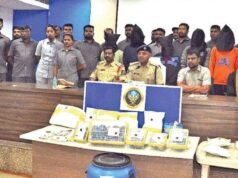New Delhi A sharp increase between the initial and final voting percentage in the first and second phases of the parliamentary elections has led to apprehensions in the mind of the electorate, according to an application filed in the Supreme Court seeking directions to the Election Commission of India (ECI) to disclose the authenticated figures of votes polled across all polling stations on its website.

The application moved by Association for Democratic Reforms (ADR) in a pending matter on Thursday also took exception to the “unreasonable delay” shown by ECI in disclosing the data on votes polled. The detailed data for first phase voting was disclosed 11 days after voting on April 19 and that for the second phase, 4 days after the voting on April 26, the petition said.
Full coverage of Lok Sabha Election 2024
Soon after voting for the two phases ended, ECI issued a press release giving tentative voter turnout across 21 states and union territories to be 60% in first phase and 60.96% for second phase as of 7 pm. The revised data published on April 30 recorded an increase of nearly 6 percentage with the total voting figures for the two phases being 66.14% and 66.71%, it added.
To be sure, provisional voting percentages published by the ECI changed from polling day to later in the election (before the counting of votes) even in the 2019 Lok Sabha election. In a May 10 press note, ECI published a timeline of ECI’s press releases on provisional voting percentages for the 2019 Lok Sabha election. This shows that in the 2019 Lok Sabha elections, ECI’s two press notes on provisional voting percentages were published 5-7 days apart in each phase, with the highest difference between the two provisional figures 3.4 percentage points in the second phase of the 2019 election. However, the second provisional figure for the first phase polls in 2024 was published 11 days after the poll.
Also Read | Lok Sabha Election 2024: Malkajgiri constituency with highest voter count set for triangular contest
The application, filed by advocate Prashant Bhushan, also said: “ECI not releasing absolute number of votes polled, coupled with the unreasonable delay in release of votes polled data, has led to apprehensions in the mind of the electorate about the sharp increase between initial data and data released on April 30.”
Asking EC to put these apprehensions to rest, the application further added, “In order to uphold the voter’s confidence, it is necessary that ECI be directed to disclose on its website scanned legible copies of Form 17C Part- I (Account of Votes Recorded) of all polling stations which contains the authenticated figures for votes polled, within 48 hours of the close of polling.”
The application asked the court to direct the poll panel to put out the authenticated record of voter turnout by uploading on its website scanned legible copies of Form 17C Part-I (Account of Votes Recorded)of all polling stations after each phase of polling. It also sought a tabulation of the constituency and polling station wise figures of voter turnout in absolute numbers and in percentage form for the current general elections. In addition, the application urged the ECI to disclose the candidate-wise result of counting which is recorded as per Part- II of Form 17C.
ADR filed the application in a pending petition filed by it in 2019 raising concerns over the electronic voting machines (EVM). The fresh application, which is likely to be mentioned for hearing next week, said that the “inordinate delay” in the release of final voter turnout data coupled with the “unusually high revision” and the “absence of disaggregated constituency and polling station figures” has raised “public suspicion” on the correctness of the data put out by EC.
The application has opened a new front of attack against the EC which is already battling concerns from political parties — including the Trinamool Congress, the Communist Party of India (Marxist) and the Congress — over polling data.
On May 7, the Congress chief wrote a letter to leaders of the INDIA bloc, alleging discrepancies in the voting data released by the poll body. The ECI hit back on Friday rejecting the charges of mismanagement and delay in the release of voter turnout data in the first two phases of the Lok Sabha elections and termed Kharge’s allegations “unwarranted”, “without facts” and “reflective of a biased and deliberate attempt to spread confusion”.
The data on turnout available so far shows that the turnout in 280 PCs (all PCs outside Jammu and Kashmir) that have voted so far is 66.1%, 2.7 percentage points less than the in 2019. In absolute terms, 326.7 million people have voted in these 280 PCs, 3% more than in 2019. A PC-wise analysis shows that in the 266 PCs for which this comparison is possible (all PCs excluding those in Jammu and Kashmir and Assam whose boundaries have been redrawn since 2019) turnout percent has decreased in 200 PCs. Of these 200 PCs, 167 PCs have registered a decline of more than 2 percentage points, 71 of more than 5 percentage points, and seven of more than 10 percentage points. In absolute terms, turnout has declined in 95 PCs. Among these 95 PCs, absolute turnout has declined by more than 2% in 63 PCs, by more than 5% in 30, and by more than 10% in five. To be sure, this analysis is based on first and second phase data as published by ECI in press release on April 30, but phase 3 data as updated on ECI’s Turnout App up to 6:30 PM on May 10. The number of PCs with a decline in turnout can decrease if turnout is revised higher for phase 3.





